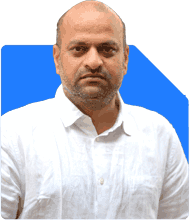Ramalingam Kalirajan |2691 Answers |Ask -Follow
Mutual Funds, Financial Planning Expert - Answered on May 08, 2024
He has an MBA in finance from the University of Madras and is a certified financial planner.
He is the director and chief financial planner at Holistic Investment, a Chennai-based firm that offers financial planning and wealth management advice.... more

How much is it advisable to have a seperate health insurance apart from CGHS provided for government employee? Is it advisable to take one from outside to secure family members health or not required? I need to know about post retirement also. Will be CGHS card sufficient after post retirement?
Here are some points to consider regarding health insurance for government employees and post-retirement:
1. Coverage for Dependents: CGHS typically covers the employee and dependent family members. However, having a separate health insurance policy can offer additional coverage options for family members, including parents, spouse, and children.
2. Wider Coverage and Flexibility: A standalone health insurance policy from an insurance provider offers a wider range of coverage options, including pre-existing conditions, critical illnesses, and outpatient expenses. It also provides flexibility in choosing hospitals and medical facilities.
3. Post-Retirement Coverage: CGHS coverage continues post-retirement for pensioners who opt for it. However, having a separate health insurance policy can provide additional coverage options and flexibility, especially as healthcare needs may evolve with age.
4. Comprehensive Protection: While CGHS provides comprehensive coverage, having an additional health insurance policy ensures comprehensive protection against medical expenses, ensuring peace of mind for you and your family.
In summary, while CGHS coverage provides significant benefits for government employees and pensioners, having a separate health insurance policy can offer additional coverage options, flexibility, and peace of mind, especially for family members. It's advisable to assess your healthcare needs, family composition, and budget to determine the most suitable health insurance coverage for you and your family.
Best Regards, K. Ramalingam, MBA, CFP, Chief Financial Planner, www.holisticinvestment.in
You may like to see similar questions and answers below
Sanjib Jha | Answer |Ask -Follow
Insurance Expert - Answered on Oct 12, 2022
Sanjib Jha | Answer |Ask -Follow
Insurance Expert - Answered on Apr 13, 2023
Moneywize |107 Answers |Ask -Follow
Financial Planner - Answered on Apr 23, 2024
Ramalingam Kalirajan |2691 Answers |Ask -Follow
Mutual Funds, Financial Planning Expert - Answered on Apr 23, 2024
Ramalingam Kalirajan |2691 Answers |Ask -Follow
Mutual Funds, Financial Planning Expert - Answered on May 08, 2024
Ramalingam Kalirajan |2691 Answers |Ask -Follow
Mutual Funds, Financial Planning Expert - Answered on May 20, 2024
Ramalingam Kalirajan |2691 Answers |Ask -Follow
Mutual Funds, Financial Planning Expert - Answered on May 20, 2024
Ramalingam Kalirajan |2691 Answers |Ask -Follow
Mutual Funds, Financial Planning Expert - Answered on May 20, 2024
Ramalingam Kalirajan |2691 Answers |Ask -Follow
Mutual Funds, Financial Planning Expert - Answered on May 20, 2024
Ramalingam Kalirajan |2691 Answers |Ask -Follow
Mutual Funds, Financial Planning Expert - Answered on May 20, 2024
Ramalingam Kalirajan |2691 Answers |Ask -Follow
Mutual Funds, Financial Planning Expert - Answered on May 20, 2024
Ramalingam Kalirajan |2691 Answers |Ask -Follow
Mutual Funds, Financial Planning Expert - Answered on May 20, 2024
Ramalingam Kalirajan |2691 Answers |Ask -Follow
Mutual Funds, Financial Planning Expert - Answered on May 20, 2024
Ramalingam Kalirajan |2691 Answers |Ask -Follow
Mutual Funds, Financial Planning Expert - Answered on May 20, 2024
Ramalingam Kalirajan |2691 Answers |Ask -Follow
Mutual Funds, Financial Planning Expert - Answered on May 20, 2024
























